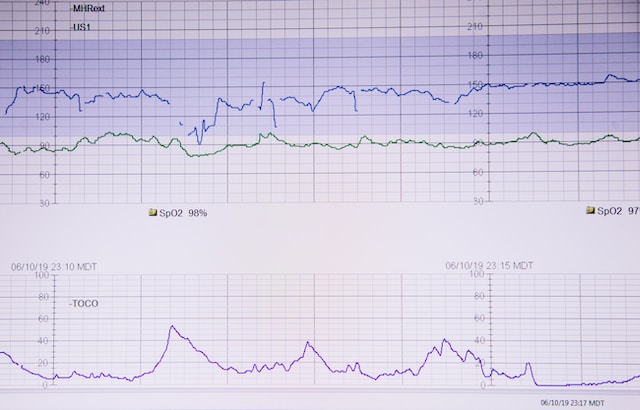Guideline – CTG/Telemetry (wireless)
CTG is used to determine the heartbeat of the baby and the mother (5.2)(16).
The well known belt is fitted with electrodes and strapped around the woman's abdomen. It must not slip, so the woman must lie down. Alternatively, there is the recording by telemetry. With this wireless CTG monitoring, the woman can move freely.
This should be offered to all women, according to the guideline. "Interpretation of CTG recordings using computerized systems should not currently be used routinely." (5.56) CTG should not be the sole determinant.
Other aspects should be included in the overall assessment of the infant's condition. CTG as a diagnostic tool is controversial. In every second child, the CTG is misinterpreted so that the baby's state of health is incorrectly assessed, with potentially serious consequences. The high number of misinterpretations is reported by the German Society of Gynecology and Obstetrics (DGGG). (8)
 CTG is often the intermediate step in the chain of interventions leading to incisional delivery: Oxytocic > PDA > CTG (misinterpreted) > cesarean section.
CTG is often the intermediate step in the chain of interventions leading to incisional delivery: Oxytocic > PDA > CTG (misinterpreted) > cesarean section.
Oxytocics require mandatory CTG monitoring. CTG monitoring with a high rate of misinterpretation leads to a high number of caesareans. The use of CTG stands or falls with the one-to-one care by a midwife, which is also required for clinics. If this level of care is not provided clinically, women will be prescribed the CTG.
In order to avoid "labor pains", we recommend to deal extensively with the latency phase when the birth starts.
(8) „Gegen den Trend – Wie es gelingen kann, die Kaiserschnittrate zu senken“ Broschüre des Arbeitskreises Frauengesundheit in Medizin, Psychotherapie und Gesellschaft e.V. (AKF)
(16) These numbers refer to the location in the abbreviated version of the guideline "Vaginal Birth at Term."
